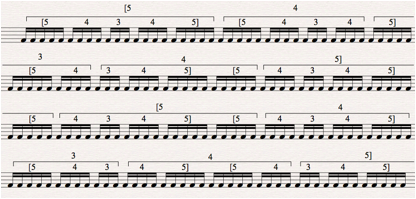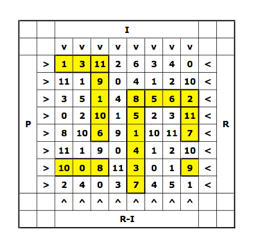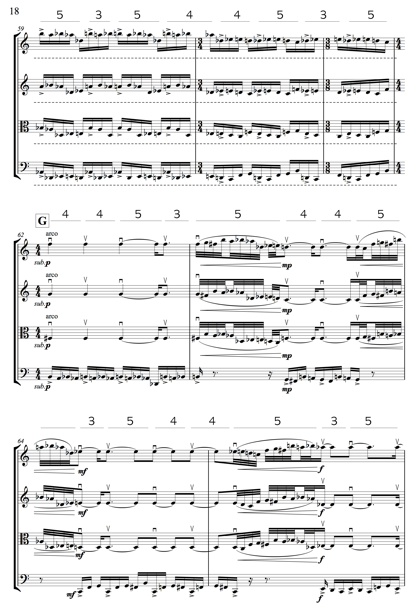A compositional system inspired by fractals
Amos Elkana
fractal |ˈfraktəl| |ˌfrøktəl| |ˌfrakt(ə)l| Mathematicsa curve or geometric figure, each part of which has the same statistical character as the whole. Fractals are useful in modeling structures in which similar patterns recur at progressively smaller scales, and in describing partly random or chaotic phenomena such as crystal growth, fluid turbulence, and galaxy formation.
The 20th century liberated western art music from the constraints of the tonal system[1]. The tonal system that was practiced all over the western hemisphere during the 17th, 18th and 19th centuries, governed not only the organization of pitch but also dictated other aspects of music composition such as structure. The more creative composers of that period knew how to bend and shape this system to meet their needs and desires but even so were still working within it.
Progressively through the 20th century all past rules and traditions of composition were subject to questioning and rethinking. No other system that was invented since then was as comprehensive as the tonal system and none created a following strong enough to last. Perhaps this was not, and still isn't, due to the quality of the ideas but to the freedom composers now have to invent systems that are original and best suit their own way of thinking.
Structure
Some time ago I decided to change my method of composing. I wanted to experiment with predefining the structure of a composition before considering other aspects of it such as pitch organization, rhythmic organization, orchestration, etc. I thought it would be interesting to invent a predefined structure that I can "pour" my musical ideas into, something like the sonata-form that was traditionally thought of as a well defined musical structure and that was pretty much unaltered during the 18th and 19th centuries. In previous works I often did not plan the structure of a new composition in advance. I might have had initial ideas regarding structure but I needed to let the form take shape intuitively as the compositional process came along. Now I wanted to set up a rigorous predefined form that will be divided into clear musical sections and will allow me the liberty of "pouring" music into them.
As a result I came up with a method for the creation of a type of musical form that I call the fractal form.
This method draws inspiration from two unrelated ideas. The first one is the way in which an ordinary book is structured: The smallest unit in a book is the letter. Grouping some letters together create words. Grouping some words together create paragraphs. Paragraphs create chapters. Chapters create a book. This was the first idea. The second one was the fractal notion that "… similar patterns recur at progressively smaller scales". If you look at a fractal image and then you zoom in on a part of the image the zoomed in part looks exactly the same as the whole image.
 ►
►
 ►
►

The first thing to do was to find the musical equivalent of a letter. Initially one would probably think that the musical equivalent of a letter would be pitch (even the names of the different pitch are letters) but actually since the structure of a piece of music can only be experienced in relation to time, the basic unit must be a unit of duration, for example a 16th note.
An imaginary row of infinite 16th notes is written and then divided into groups in order to make words (words=motives?). These words are then grouped together to form sentences (sentences=phrases?) and so on: sentences/phrases into paragraphs/periods, paragraphs/periods into chapters/movements and chapters/movements into a book/composition.
The next thing to do was to invent a system that will enable me to divide this row of notes into groups in some logical way. Using a series of numbers that were randomly[2] chosen I began dividing this imaginary row of 16th notes into small groups. As an example, the following series of numbers will be used: [5,4,3,4,5]. The first number in this series is five so I grouped the first five notes together. The next number in the series is four so I took the next four notes and grouped them together. The number after that is three so I grouped the next three notes together and so on. When I reached the last number of the series I started again with the first number looping over and over again: [5,4,3,4,5] [5,4,3,4,5] [5,4,3,4,5]…
![]()
Once I created words/motives out of the row of notes, I started grouping the words/motives into sentences/phrases in a similar way: the first five words make up the first sentence the next four words make up the second sentence and so on.

I did the same for paragraphs/periods and chapters/movements. This processes continued up to the chapter/movement level. Once the paragraphs/periods were grouped into movements/chapters the process ended since I decided that the number of movements/chapters in my composition/book would be the same as the amount of numbers in my series. In this example the composition is made of five movements since the series contains five numbers [5,4,3,4,5]. [3]
Now that I had a predefined structure for the new composition I could begin thinking about other aspects of it.
Pitch organization
I use a tone matrix[4] to organize the pitch material for composition. This ordered set of tones, unlike the traditional 12-tone matrix, could contain any number of tones, in any order and some might even be repeated within the original set. The advantage of using a tone matrix is, of course, that all rows are derived from one and therefore all musical ideas taken from the matrix are musically connected.
The tone matrix acts as a pool of tones from which I draw all the pitch material. By randomly selecting single tones the matrix loses its purpose. In order to create musically connected ideas, I impose the three consecutive notes rule: at least three consecutive notes, in any direction, must be used before jumping to a different point in the matrix. The following example is of a tone matrix that was derived from the prime row 1,3,11,2,6,3,4,0. This row contains eight tones (one of which is repeated). Six groups of notes are highlighted. The horizontal groups are either parts of prime rows or retrograde rows while the vertical groups are either parts of inversion rows or retrograde-inversion rows. Notice the group of notes that are taken from the sixth transposition of the prime: 9,10,0,8. The first tone of this group starts with the last tone of the seventh row and the second tone is the first in this row. This is to say that the starting and ending points of rows in the matrix is irrelevant since a row may be looped.

The same tone row may also be used, in different ways, to derive the series of numbers that create the fractal form as explained above. One way is to simply use the numbers of the tone row as the numbers for the fractal form. This might cause a difficulty since the tone row contains numbers that are unsuitable for producing the fractal form (the number 0 for example). Another way, that eliminates this problem and also results in fewer numbers, is to calculate the intervals between the tones in the tone row. And yet another way, that I personally have been using quite often, is a bit more complicated but results in series of numbers that are particularly suited for generating fractal forms. Here, I calculate the smallest interval between two notes and then sum up every two consecutive intervals. The following table exemplifies this method:
|
Tone Row |
1 |
3 |
6 |
4 |
8 |
11 |
10 |
12 |
2 |
5 |
7 |
9 |
1 |
|
Intervals |
2 |
3 |
2 |
4 |
3 |
1 |
2 |
2 |
3 |
2 |
2 |
4 |
|
|
Fractal set |
5 |
6 |
4 |
4 |
5 |
6 |
|||||||
Rhythmic organization
As stated above, the fractal form is built from a chosen basic unit of duration. This implies that the rhythmic organization already exists in the structure of the composition. It doesn't mean however that the duration of every note is the same. Many different note durations can be extracted from the fractal form. If a letter is the equivalent of a 16th note then a word made up of five letters can be composed as five discrete16th notes or a single note with a duration of one quarter tied to a 16th.
Here are a few examples of the rhythmic possibilities within this system:

The following excerpt from my String Quartet No. 2 is an example of these techniques. The series of numbers used to create this fractal form is 4,5,3,5,4. In this example one can easily see the subdivisions since the groupings usually begin with an accented note.

Excerpt from String Quartet No. 2 by Amos Elkana
Conclusion
In this short essay I have touched upon two aspects that are inextricably linked together, Structure and Rhythmic Organization, and another aspect, Pitch Organization, that is generally not linked with the former two. Fortunately, as I have shown, I found a way to extract the series of numbers that make the fractal form from the chosen tone row and thus everything in this system comes from the same source and is linked together. I personally prefer to leave other aspects such as dynamics and timbre for intuition.
Almost all of my compositions since 2003 use this method. You can listen and read the scores of my works here:
www.amoselkana.com/compositions.php
[1] It is important to restate the difference between the tonal system and tonal music. The tonal system was a system that not only established a tonal center, but also relied on major-minor scales and harmonies, cadenzas, particular forms, etc. Tonal music, on the other hand, can be implied to any music that establishes a tonal center. Many examples of tonal music can be found in world music and contemporary art music as well.
[2] Eventually, In order to make a connection between structure and pitch organization, I extracted the series of numbers from the notes themselves instead of choosing them randomly.
[3] Needless to say that doing all this by hand takes way too much time so I wrote a small computer program that does it for me. The program lets you enter a series of numbers and then prints out the structure made by that series. I call it the Fractal Form Generator.
[4] A tone matrix is modeled after the 12-tone matrix that was implied by Schoenberg's method of composing with 12 notes that are related only to one another. A 12-tone matrix displays all the possible variations of an ordered set of the notes of the chromatic scale.
Copyright © Amos Elkana 2006